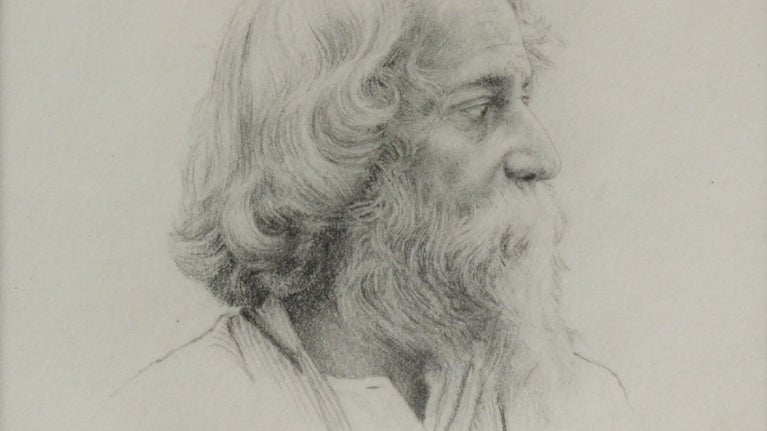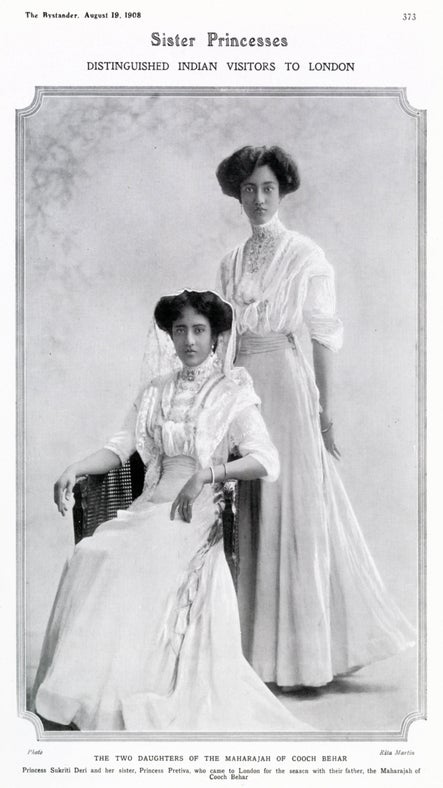
A musical journey into South Asian Heritage
Discover a specially curated playlist by DJ Punit for South Asian Heritage Month 2024, inspired by three musical items from the collections we care for.

Some of the places and collections we care for reveal South Asian stories, reflecting the UK's diverse heritage and cultural links to the region. Learn more about the history of the people and objects behind these connections, from princesses to a peacock dress.
Princesses Pretiva (1891–1923) and Sudhira (1894–1968) were the daughters of the Maharajah and Maharani of Cooch Behar in West Bengal, India. They married two brothers from Wightwick Manor: Pretiva married Lionel (or Miles) Mander in 1912, and Sudhira married Alan Mander in 1914.
The princesses’ mother, Maharani Suniti Devi, was a pioneering women’s rights campaigner, passionate about women’s education. She was also the first President of the All-Bengal Women’s Union, a society set up to help the state's most vulnerable women.
Sudhira followed in her mother’s footsteps, campaigning for better relations between England and India and speaking out for women’s suffrage in India. She also worked for the Red Cross during the First World War, where she met Indian suffragette Princess Sophia Duleep Singh, the goddaughter of Queen Victoria.
In 1915, Sudhira and Sophia were honoured at a ceremony for Red Cross activists who'd attended special war classes in first aid, nursing and the care of patients.

A pencil portrait on paper of the Bengali poet, songwriter, novelist and activist Rabindranath Tagore (1861–1941) forms part of the collection at Shaw's Corner, where playwright and critic George Bernard Shaw (1856–1950) lived for 44 years. It was gifted to him by the artist Singannachar Narasimha Swamy (1911–1983).
Rabindranath revolutionised Indian art and literature, composed the national anthems of India and Bangladesh and had a profound influence on the words and music of the Sri Lankan national anthem.
He was a pioneer of the Bengal Renaissance Movement, championing the cause of indigenous art forms, literature and education. As such, he became a Bengali cultural icon. He was also admired by Western writers such as W. B. Yeats and George Bernard Shaw.
In 1913, Rabindranath became the first non-European to receive the Noble Prize for Literature and later that year visited the Shaw family at Adelphi Terrace in London.
The handcrafted Peacock Dress is one of the most ornate pieces in the collection at Kedleston Hall. The dress is embroidered with intricate silk and gold peacock feathers, which is a symbol of great significance in Indian culture and the Hindu religion.
The embroidery was handcrafted by professional gold thread Indian embroiderers at the workshop of Kishan Chand in Delhi, India, before being sent to Paris to be made into a dress by couture designers, House of Worth. It was then sent back to India to be worn by Lady Mary (1870–1906) of Kedleston Hall at the Delhi Durbar Ball in January 1903.
The ball was designed to entertain and impress Indian princes and dignitaries, all while underlining the power of British rule. Lady Mary and her husband, Lord Curzon (1859–1925), were Vicereine and Viceroy respectively of India from 1899 to 1905, appointed by the British monarchy to govern what was then British India.
The dress’ design may have been subtly political. The fabric used in its design was traditionally worn by Mughal court rulers – before the Mughal Empire was dissolved when Britain made India part of their empire.

The Sultan of Surat is an equestrian portrait of a figure with a hawk, in front of the River Tapti, at Surat, in Gujarat, Western India. It forms part of the collection at Studley Royal. Much mystery surrounds the painting and research is underway as part of its restoration to discover more about the story behind its creation.
We ask for your permission before anything is loaded, as this content may introduce additional cookies. You may want to read the Google YouTube terms of service and privacy policy before accepting.
Go behind the scenes at the Royal Oak Conservation Studio in Knole, Kent, where we're working to restore The Sultan of Surat, an 18th-century oil painting. Our conservators have been removing surface layers of varnish and overpainting from previous restorations and through collaborative research, we're getting closer to revealing hidden clues about the artist and subject.
With more than 1,000 items dating from around 1600 to the 1830s, the objects and artefacts in the Clive Collection at Powis were gathered by two generations of the Clive family: Robert Clive (1725–1774), a central figure in the establishment of British imperial control of India; and his son, Edward (1754–1839) and daughter-in-law, Henrietta (1758–1830), daughter of the Earl of Powis.
The Clive family had been at the centre of the East India Company's expansion in India, collecting Indian artefacts and building a large fortune in the process. Although some items in the collection were purchased or received as gifts, others were taken as spoils of war.
When Edward and Henrietta returned from India in the early 19th century, they brought with them the wealth the Clive family had amassed, renovating the castle and gardens at Powis. They also brought with them the vast colonial collection, which was presented together, for the first time, in the Clive Museum in the 1980s.
Objects in the collection include a tent that belonged to the ruler of Mysore, Tīpū Sultān, seized by Edward Clive, then Governor of Madras, following the death of Tīpū Sultān at the Siege of Srirangapatna in 1799.
Powis Castle is home to the largest private collection of South and East Asian artefacts of their kind in the UK.

Some of the items and collections in our care represent a legacy of British colonialism and show us how connections remain visible at a number of places we look after. You can find out more about how we’re looking at the challenging histories attached to places like Powis Castle as well as other places in our care as we address histories of colonialism and historic slavery at the places we care for.

Discover a specially curated playlist by DJ Punit for South Asian Heritage Month 2024, inspired by three musical items from the collections we care for.

Read our report on colonialism and historic slavery in the places and collections we care for and discover how we’re changing the way we approach these issues.

The East India Company was probably the most powerful corporation in history. At its height, it dominated global trade between Europe, South Asia and the Far East, fought numerous wars using its own army and navy, and conquered and colonised modern day India, Pakistan, Bangladesh and Burma.

The art and heritage collections we care for rival the world’s greatest museums. Learn more about the collection of paintings, decorative art, costume, books, household and other objects at historic places.

We're committed to meeting the needs and expectations of a diverse society. Find out what we're doing to create an inclusive, accessible and welcoming environment for our supporters, staff and volunteers.